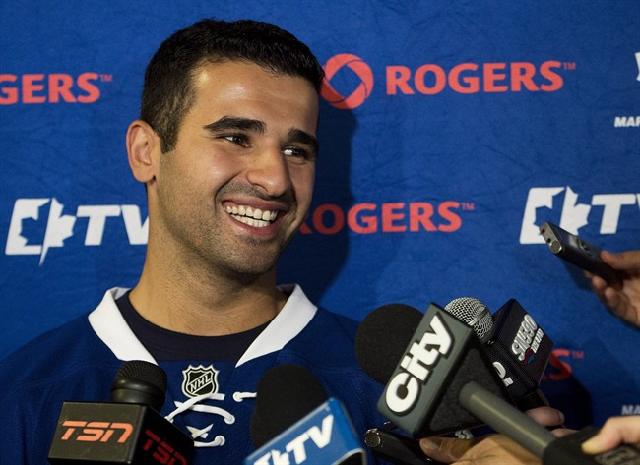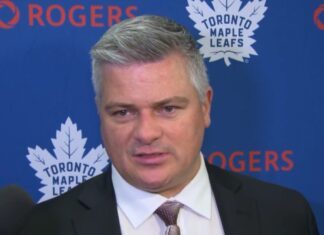As training camps opened this week, the last of the RFAs have begun to re-sign with their clubs. Most notably, Leaf phenom Nazem Kadri signed a two year pact that will pay him $2.9-million per season. A hundred or so miles down the road, the Buffalo Sabres locked up their star RFA centre Cody Hodgson to a six-year deal at $4.25-million per year.
Last season, Kadri had a stellar 44 points in 48 games; Hodgson had a good but not great 34 in 48 games. For their careers, Kadri has a .636 points per game average (63 points in 99 games played) compared to Hodgson’s .554 (73 pts in 139 GP). So why does Hodgson get $20-million and four years more than Kadri?
The choices undertaken by the Sabres and the Leafs with their RFA centres were entirely situational. Let’s face it: Buffalo is going to have every opportunity to be one of the league’s worst teams this season. The Sabres aren’t paying Hodgson for his efforts in the short term. Should Hodgson develop into a 60+ point centre over the course of this deal, his cap friendly contract will allow for the team to add key pieces well down the road. Another benefit of paying a premium for Hodgson in the short term is that it will allow the Sabres to shed a lot of salary via trade while still remaining above the cap floor, possibly expediting their forthcoming rebuild.
In general, the Sabres are long on Hodgson, and hope that he’ll develop into a top flight centre. The hope is that he far outperforms the contract by the third year on, and plays out the prime of his career at a reduced number compared to his actual worth.
It’s a bold decision, and not without merit. Philadelphia Flyers GM Paul Holmgren took the same risk with current Leaf James van Riemsdyk two seasons ago, and the early returns have been terrific. But the margin for this type of deal to backfire is wide enough to be wary. If Hodgson doesn’t develop, his contract quickly becomes a bit of an albatross. He’ll become a lightning rod for criticism as a highly paid player on a failing team.
For the Leafs, they are closer to Stanley Cup contention; and with their previous offseason transactions, needed to get Nazem as cheaply as possible. The only way Kadri could fit into the Leafs management’s blue print in the immediate future was to conform to a bridge contract. With a very modest sum and a two year deal, the Leafs are able to ice a better team in the short term (especially if they can find a way to re-sign lone holdout Cody Franson). There is risk in the Leafs being stingy with term and dollars, but I think it’s ultimately the safer route when negotiating contracts.
For starters, it’s no certainty that Kadri lives up to his production from last season, or that he’ll develop into a top line centre. Even moderate regression in his game as Cam Charron points out, turns Kadri into a 50-point second line centre. Good, not great, and probably not worth either the six year term or the $4.25-million cap hit that Hodgson already has. The Leafs are betting the under on Kadri’s talent ceiling, and that’s fairly prudent.
For all of his plaudits, Kadri’s breakout season was potentially illusory. With 44 points in 48 games, roughly two-thirds of Kadri’s offensive totals were accrued in roughly half of his NHL career to date. His body of work is about 30% smaller than Hodgson’s, and so forecasting his development is even more difficult. It really didn’t make sense yet to invest in Kadri long term from the Leafs management’s perspective. And in the chance he doesn’t develop into a top offensive threat, he’s still moveable; Hodgson less so with a high number and a back-loaded payout on his deal.
Consider this: Kadri’s miraculous performance in 2013, over an 82-game schedule, comes to 75 points. Had such a thing occurred, there would have been no discussion of a bridge contract. Kadri would have earned top dollar and long term, and it might have required the Leafs to completely rearrange their offseason spending (which – admittedly – wouldn’t necessarily have been a bad thing). This bridge deal could be quite fortuitous if it helped to ice a more competitive team now.
An interesting case study in how the Leafs strategy to bridge Nazem could work out in the long term, look no further than Sam Gagner. The Edmonton Oilers’ sixth overall pick from 2007 presents an interesting comparison. Through 414 games, Gagner has scored at .623 points per game pace, and is just now developing into something more than a good second line centre.
He, like Kadri, signed a reasonable bridge contract after his entry level deal expired in 2010 (2 years, 2.275 AAV). Gagner then filed for arbitration after two seasons of mild regression before settling on a one-year, 3.2-million dollar contract with the Oilers in 2012. He had a career year in the lockout shortened 2013 season and went on to sign a 3-year deal that carries a $4.8-million cap hit (avoiding arbitration for a second time) and that carries him into UFA.
Should Kadri’s career development mirror that of Gagner’s, then the prudence of the bridge contract will have been recognized. And the fact remains, with the two discounted years, Kadri could earn as much as $4.9-million on his next contract and still have eaten up less total cap space that Hodgson over the course of six seasons. So there’s chance that the Leafs can keep Kadri in the fold at a reasonable number even if he does perform well.
The only way the bridge contract goes bad for the Leafs is if Kadri continues to shoot the lights out in Toronto over the next two seasons, warranting a long-term deal similar to San Jose’s Logan Couture (6 years, $6-million AAV). I’m sure that if the Sharks could go back in time, they’d have been much more amenable to offering Couture a longer term at a discounted rate.
Ultimately, the greatest risk facing the Maple Leafs with their signing of Nazem Kadri to a bridge deal boils down to the fact that they might have to pay market value for a star player in the not too distant future. But even so, that’s mitigated by the static nature of a player’s cap hit as time goes on. With the more bullish estimates suggesting the salary cap will grow to $80-million in just three seasons, the value of any contract signed now is only set to improve. So even if the Hodgson deal doesn’t pan out perfectly, it could be worth less than 5% of the total salary cap by the time the deal is up (it’s about 6.6% now). Even at $6-million a season, Kadri would represent only 7.5% of an $80-million cap.
It will be interesting to see how Nazem Kadri and Cody Hodgson’s deals pan out. It’ll take years to get the full story, but here’s a tautology that Dave Poulin once told to me about contract negotiations: you always want to sign a guy for less. And the Leafs did just that with Naz.
Friday Morning Links:
ICYMI, Anthony Petrielli previewed the Maple Leafs forward corps ahead of the 2013/14 NHL season
PPP’s Top 25 Under 25 votes revealed.
TLN’s Top 20 continues with No. 2 on the list, Joe Colborne.
The Globe’s James Mirtle with 5 Keys to watch for in training camp.
























![[Leafs Links] Reports: Sean Walker likely to be moved, Maple Leafs have inquired; the latest on Chris Tanev, Noah Hanifin, Adam Henrique, Scott Laughton, Jakob Chychrun & more Sean Walker linked to the Maple Leafs](https://mapleleafshotstove.com/wp-content/uploads/2024/01/sean-walker-maple-leafs-flyers-218x150.jpg)
![[Leafs Links] The asking price for Sam Lafferty and Vladislav Gavrikov, the latest on Patrick Kane, and is Toronto lurking as a darkhorse on Timo Meier? Patrick Kane, Chicago Blackhawks trade rumours](https://mapleleafshotstove.com/wp-content/uploads/2023/02/patrick-kane-blackhawks-218x150.jpg)
![[Leafs Links] Marlies head coach names a defenseman to look out for in the Leafs’ farm system; Bruins sniffing around on Chychrun, Schenn; a timeline for Patrick Kane and Jonathan Toews’ deadline decisions Jakob Chychrun, Toronto Maple Leafs trade target](https://mapleleafshotstove.com/wp-content/uploads/2022/02/jakob-chychrun-218x150.jpeg)









